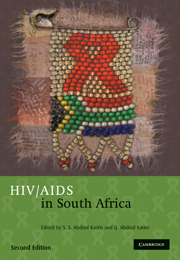Book contents
- Frontmatter
- Contents
- List of Contributors
- Foreword: Peter Piot
- Foreword: Nelson R Mandela
- Acknowledgements
- Section 1 Birth of a rapidly growing epidemic
- Section 2 The virus, the human host and their interactions
- Section 3 HIV risk factors and prevention strategiess
- Section 4 Focal groups for understanding the HIV epidemic
- 17 Heterosexual transmission of HIV – the importance of a gendered perspective in HIV prevention
- 18 Young people and HIV/AIDS in South Africa: prevalence of infection, risk factors and social context
- 19 Female sex workers
- 20 Population movement and the spread of HIV in southern Africa
- Section 5 The impact of AIDS
- Section 6 Treating HIV
- Section 7 What does the future hold?
- Index
18 - Young people and HIV/AIDS in South Africa: prevalence of infection, risk factors and social context
Published online by Cambridge University Press: 07 September 2011
- Frontmatter
- Contents
- List of Contributors
- Foreword: Peter Piot
- Foreword: Nelson R Mandela
- Acknowledgements
- Section 1 Birth of a rapidly growing epidemic
- Section 2 The virus, the human host and their interactions
- Section 3 HIV risk factors and prevention strategiess
- Section 4 Focal groups for understanding the HIV epidemic
- 17 Heterosexual transmission of HIV – the importance of a gendered perspective in HIV prevention
- 18 Young people and HIV/AIDS in South Africa: prevalence of infection, risk factors and social context
- 19 Female sex workers
- 20 Population movement and the spread of HIV in southern Africa
- Section 5 The impact of AIDS
- Section 6 Treating HIV
- Section 7 What does the future hold?
- Index
Summary
AMONG YOUNG PEOPLE IN sub-Saharan Africa, the HIV epidemic is superimposed on already poor sexual health outcomes, including high levels of unintended pregnancy. Young people, particularly women, are disproportionately represented in the epidemic, with high prevalence in the age group 15–24. In South Africa, one-quarter of young adult women aged 20–24 are now HIV infected.
Adolescence is a time of exploration and experimentation that can enhance sexual risk. Young girls face particular risks. Biological immaturity of the genital tract increases a young woman's chance of sexually transmitted infection and gender inequality decreases her negotiating power in sexual matters. Young girls are likely to be sexually active with older boys and men, who, in turn, may have multiple sexual partners. There is increasing recognition that awareness and prevention campaigns that promote abstinence, monogamy and condom use without addressing wider societal changes are not effective because they ignore existing gender inequalities that young women find difficult to overcome.
Certain social and structural factors are most commonly associated with hiv infection in young South Africans. Evidence points to associations between hiv infection and partner's age, school attendance and completion, parental absence, participation in community and sports organisations, and other measures of social capital.
Interventions in the early teen years and beyond need to address both individual and structural causes of infection. Interventions that emphasise negotiation skills, assertiveness training and self-esteem can enhance young people's ability to protect themselves.
- Type
- Chapter
- Information
- HIV/AIDS in South Africa , pp. 305 - 328Publisher: Cambridge University PressPrint publication year: 2010
- 3
- Cited by



